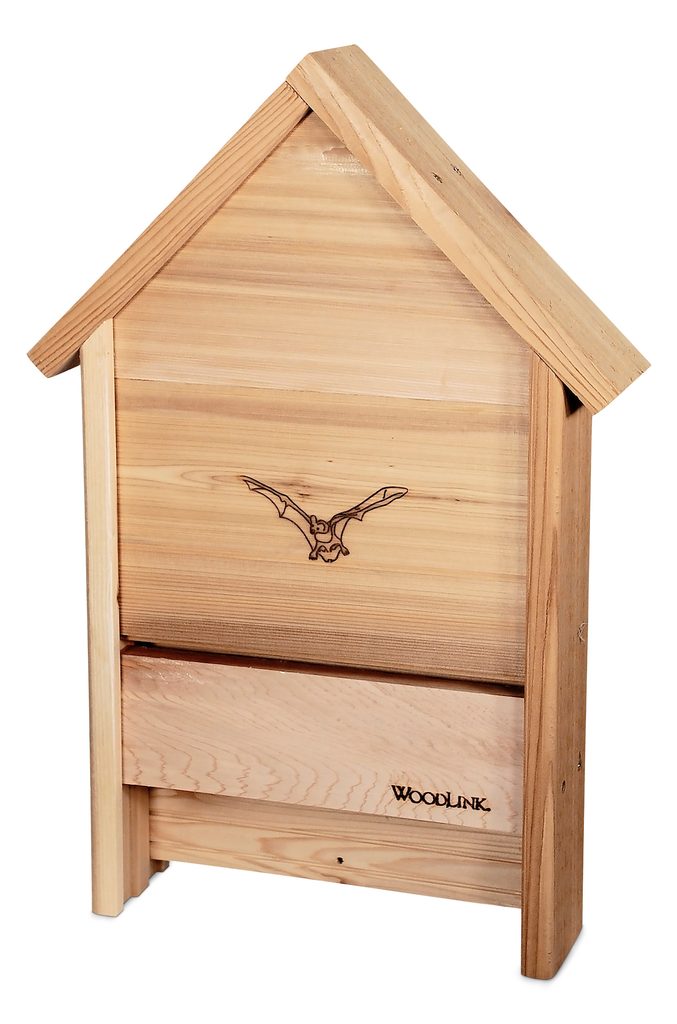
Installing a bat house may seem daunting, but it’s worth the effort. Bats eat pesky backyard bugs, and some even pollinate flowers. To be a good bat landlord, it’s important to install a house in a place where bats are protected and have access to important resources.
Here’s what you should look for when you’re buying, installing or making a bat house.
1. Find the Perfect Bat House Location
Think about where the bat house will go. Look for a spot with sun exposure that’s close to water and a mix of farmland and natural areas is ideal. Consider planting a moon garden to enjoy the backyard benefits and support bats with a source of nectar.
2. Add a Predator Guard
Just like birdhouses, bat houses can be raided by backyard predators. Mount the house on a pole and add a metal predator guard for extra security.
Check out 7 top-rated bird feeder squirrel baffles.
3. Attach the Box to a Tall Pole
Mount the house 12 to 20 feet off the ground—taller is better. It should sit above the highest vegetation beneath the house.
Where is the best place for a bluebird house?
4. Choose a Large Box
Bats can gather in sizable colonies. Pick a bat house with a large box, over 2 feet tall and 14 inches wide, to host the groups. Try this Bat House by Woodlink that has space for 25 bats.
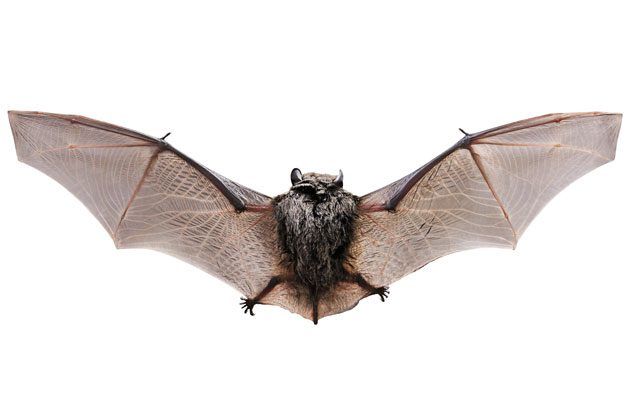
5. Use Durable Materials
Look for a house made of materials that won’t degrade easily. Wood, fiber cement and plastic are acceptable building materials.
Find out how to get rid of wasp nests in birdhouses without pesticides.
6. Keep Out Bad Weather
Well-sealed houses keep bats dry and happy, while retaining heat in cold periods.
Learn how to make a DIY bluebird house.
7. Ensure Good Ventilation
While the house should be weather-proof, properly placed vents are important for providing air circulation to the colony.
8. Paint the Box the Right Color
The warmer the climate you live in, the lighter the house should be painted or stained in order to keep the bats a comfortable temperature.
Here’s how to build a one-board DIY bird house.
9. Bats Need a Well-Placed Entrance
Look for an entrance at the bottom. It allows the bats to enter and exit easily.
Next, learn how to keep house sparrows out of bluebird boxes.

It’s easy to know when to cut back ornamental grass once you know the basics. It’s far more simple than the mowing, watering and fertilizing that may come to mind when thinking about traditional lawns. With ornamental grass, maintenance is far less intensive. Still, you can take actions to make sure your ornamental grasses sail into fall and make it through winter looking sharp.
Try these gorgeous ornamental grasses that look great throughout the seasons.
Watering and Fertilizing Ornamental Grasses
“Many homeowners like ornamental grasses because they are drought tolerant and are rarely bothered by pests,” says Iowa landscape designer Dori Hein. “They seldom need fertilizing either. Fertilizing ornamental grasses may actually cause them to flop over.”
But low maintenance does not equate to no maintenance. “Summer is the best time to keep an eye on watering needs, especially during the plant’s first year while it’s establishing roots,” Dori says. “I like to put down a natural mulch, too, because it mimics natural conditions and feeds the plants as it breaks down. Just don’t put the mulch up against the plant’s base because it can cause the crown to rot.”
Check out the top 10 perennial ornamental grasses to add to your garden.
When to Cut Back and Divide Ornamental Grasses
Once established, ornamental grasses have few needs. “The big thing with grasses is cutting them back once a year and dividing them once every four or five years,” Dori says.
Most gardeners leave their native grasses in place for winter interest and to provide food for birds. The time when you should cut back ornamental grasses is in late winter or early spring. Cut them back to within a few inches of the ground. “Cut back before the new shoots grow up through the old,” Dori adds, “or you’ll wind up cutting off the new growth, too.” In areas where wildfires are a seasonal concern, cut back grasses in fall to lessen the threat of fire.
You’ll know it’s time to divide grasses when a ring of living grass surrounds a dead center. “It’s easier to divide most grasses when they are still short from their post-winter haircut so there’s no foliage to get in the way,” Dori says. This is also the best time to divide grasses that flower in late summer and fall. Use a sharp spade or root saw and separate the living portion of the grass into smaller sections. Aim for sections that are a little bit bigger than a softball. Replant the sections, water well and enjoy through the seasons.
Ornamental Grass Benefits
Don’t miss out on these ornamental grass perks for your landscape.
- Screen unsightly utilities and other items around the yard.
- Add some privacy by rimming a patio with tall ornamental grasses.
- Soften the harsher look of a structure, fence or corner.
- Create a stage for plants to pop against the grassy backdrop.
- Offer ambiance with the relaxing sights and sounds of grasses swaying in the wind.
How to Stop Bindweed

“How do I prevent bindweed from taking over a garden bed?” asks Sue Gronholz of Beaver Dam, Wisconsin.
As you have probably discovered, bindweed is a persistent plant that’s very difficult to control. It has flowers like a morning glory, and a deep root system, which makes it drought-tolerant and difficult to eliminate. Your best bet is to keep pulling the weeds as early as possible when you see them growing. Mulching will help prevent seeds from sprouting.
Learn how to make your own weed killer with vinegar and dish soap.
You need to be diligent to win this battle. Bindweed’s roots grow up to 9 feet deep and 20 to 30 feet wide, allowing it to survive adverse conditions and normal weeding.
Pull or till the soil every three weeks for at least three years to manage the pesky weed. Continue monitoring the garden, as any piece of the root that’s left behind can regrow in several weeks and seeds remain viable for up to 50 years.
Discover the best natural way to kill weeds.
Repeated applications of a total vegetation killer is another control option. Apply carefully, following package label instructions, as these weed killers can destroy any plant they contact. This will minimize the amount of chemicals used and reduce risk to other desirable plants and the environment.
Next, learn how to manage cinquefoil and helleborine in your yard.

When it comes to appearances, there’s nothing quite like cedar waxwings and bohemian waxwings. They’re mostly covered in sleek brown plumage. But their handsome good looks are in the details—slicked-back head feathers, a black eye mask, waxy red wing tips, and a tail that looks as if it’s been dipped in yellow paint. Spotting just one of these attractive birds is a treat. But they don’t come to bird feeders. So you may be wondering what do cedar waxwings eat and how to attract them.
What Do Cedar Waxwings Eat?
Waxwings are incredibly social birds that forage in flocks year-round. But come fall, you might spot hundreds at a time descending on a single berry-filled tree or shrub. Cedar waxwings love to eat berries and fruit.
Finding them is a bit up to chance. Waxwings are nomadic; where they breed and spend winter varies each year, because they travel to places where fruit is most abundant. A flock could show up almost anywhere in the country throughout the fall and winter months.
Look for these drifters anywhere berry bushes grow—woodlands, farms, orchards, parks or your backyard. Once you spot a flock, watch for peculiar behaviors, like waxwings passing a berry to each other, or a bird plucking fruit and tossing it in the air.
Help waxwings find your yard by planting natives that produce small berries, such as dogwood, serviceberry, cedar, juniper, hawthorn or winterberry.

Less widespread than their cedar waxwing relatives, Bohemian waxwings are found in the far Northwest and in states along the Canada border in winter. There are very subtle differences between the two species. Where the ranges overlap, both species might be spotted in the same group.
Top 10 Plants to Attract Cedar Waxwings
Strawberry

Fragaria, Zones 3 to 10
The flowers attract butterflies while the berries attract waxwings and other fruit-loving birds. Watch for the beautiful red leaves in fall. June-bearing varieties produce one bumper crop per season. If you want several crops, try growing day-neutral or everbearing varieties.
Why we love it: There’s always room for strawberries, since you can grow them in the ground, in hanging baskets or in container gardens.
Winterberry
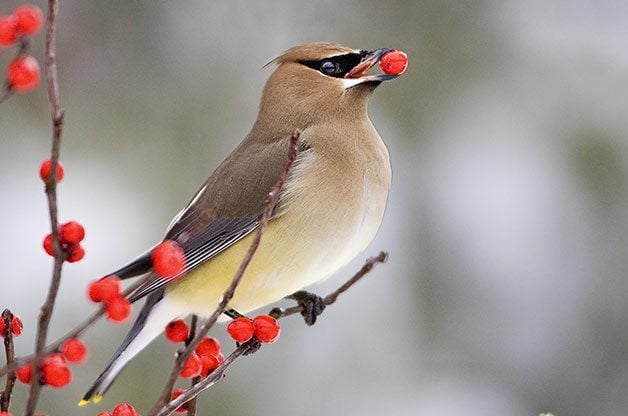
Ilex verticillata, Zones 3 to 9
The red berries of this deciduous holly brighten gray or snowy winter landscapes. Be sure to plant at least one male for every five female plants so there’s fruit for cedar waxwings to eat. Combine winterberry with evergreens and ornamental grasses for a pleasing winter scene. The plant is tolerant of wet acidic soils.
Why we love it: A few berry-covered branches will do wonders for your winter container gardens.
Juniper

Juniperus, Zones 2 to 9
From tall and slender to low and spreading, juniper comes in a wonderful diversity of shapes. The prickly evergreen needles provide shelter, while the berrylike cones offer food for the birds. Needles can be green or bluish-green and may be tipped in white or yellow. Some turn bronzy-purple for winter, while others remain green to brighten the landscape.
Why we like it: There’s at least one type of juniper that will grow in just about any part of the world.
Serviceberry
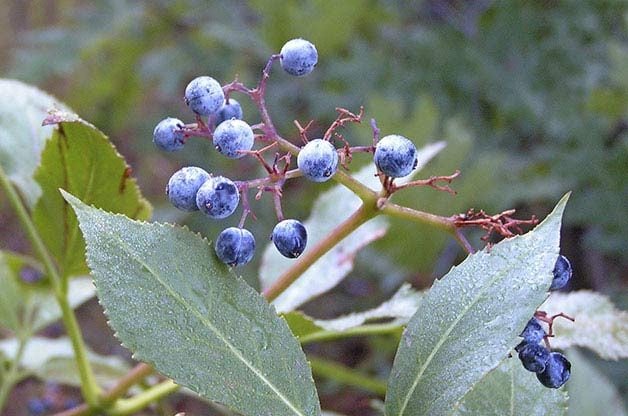
Amelanchier, Zones 3 to 9
Also know as juneberry or shadbush, this four-season beauty provides white flowers in spring, fruit in June and great fall color. When the leaves drop, they reveal beautiful smooth gray bark. Both tree and shrub forms are available in average heights of 3 to 25 feet.
Why we love it: You’re growing this plant as a way to attract waxwings, but you can enjoy this edible fruit, too. It tastes like a nutty blueberry.
Learn all about cedar waxwing baby birds and nests.
Hawthorn
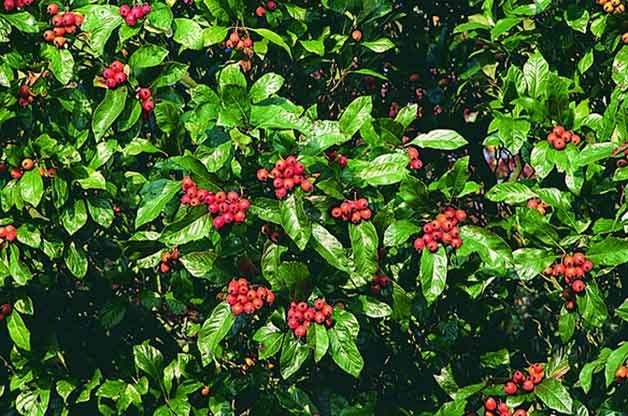
Crataegus, Zones 3 to 8
Include these small-scale plants in mixed borders, mulched beds or near other plantings where their beauty can shine but you’re protected from the thorns. Or select one of the thornless varieties for use near pathways and children’s play areas. Hawthorn’s white flowers are pretty to look at (but not to smell), and its drought tolerance makes it a good addition to water-wise gardens.
Why we love it: The fruit-laden horizontal branches are breathtaking in winter—a pretty way how to attract waxwings.
Crabapple
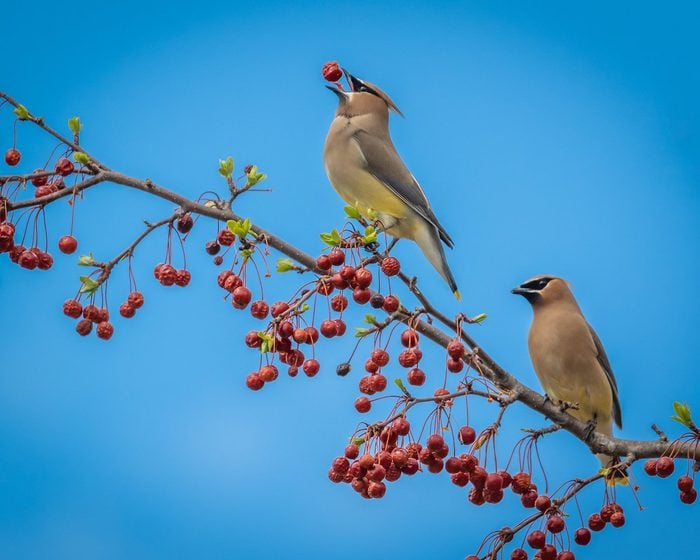
Malus, Zones 3 to 9
Everyone loves crabapple’s lightly fragrant white, pink to rosy-red spring flowers. But if you want to know how to attract waxwings, consider the colorful fruit, too. Look for fire blight- and scab-resistant varieties to increase the beauty and reduce maintenance.
Why we love it: There are so many choices! Upright, weeping and spreading forms are available with yellow, orange or red fruit.
Learn what birds eat oranges from fruit bird feeders.
Madrone
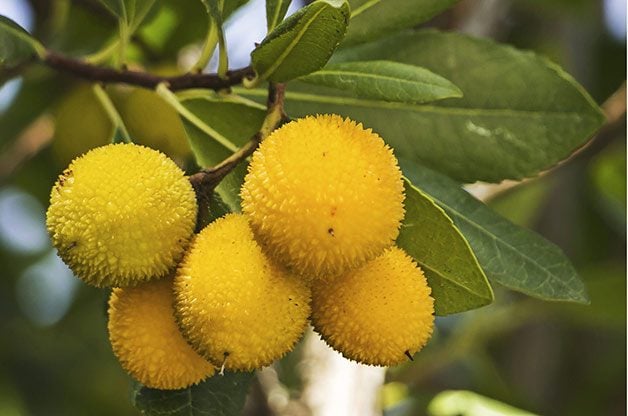
Arbutus menziesii, Zones 7 to 11
You may know this broadleaf evergreen for its elegant form and reddish-brown bark, but the waxwings know madrone for the reddish berries. The dark green leaves make a striking backdrop to the white flowers. Plant it in a mixed border or mulch bed to minimize leaf and blossom cleanup. It prefers warm, dry locations.
Why we love it: Madrone’s berry clusters may include red, orange and yellow fruit at the same time.
Check out the top 10 dwarf fruit trees for small spaces.
Mountain Ash

Sorbus, Zones 2 to 6
The North American native and European mountain ashes are small-scale trees that work well in mixed borders and less-than-spacious landscapes. Mulch the soil to keep the roots cool and moist. Proper care is critical to keeping this tree free of pests and looking its best.
Why we love it: Your extra effort in caring for this plant will pay off when a flock of waxwings feasts on the fruit in fall or early winter.
Grow potted flowers and plants that attract hummingbirds.
Elderberry
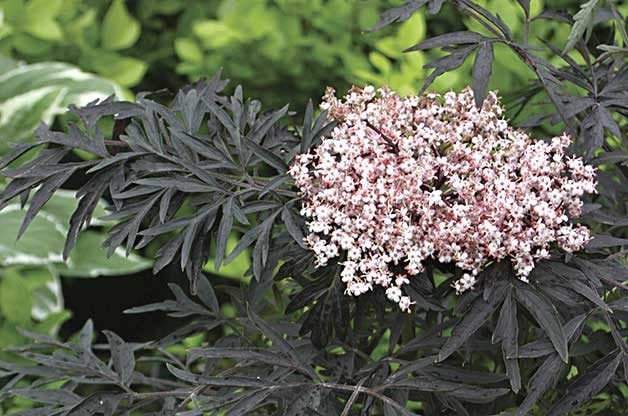
Sambucus, Zones 3 to 9
The fragrant white flowers add a bit of aromatherapy to the garden, while the fruit attracts the birds. Include elderberries in your shrub plantings and perennial gardens, or use this suckering plant to help stabilize slopes and riverbanks. Regular pruning will keep it looking its best.
Why we love it: If you have any berries left after the birds get their fill, you can use them to make your own jam, jelly or wine.
Grow these native ornamental grasses for birds and butterflies.
Raspberry
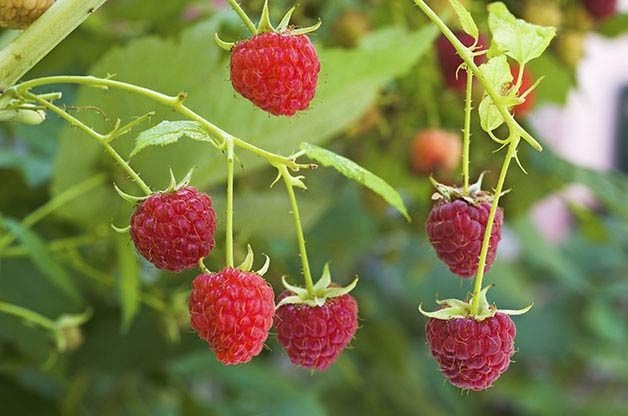
Rubus, Zones 2 to 11
Yes, raspberries are delicious, but share some with the waxwings! These vigorous plants make a great hedge, screen or barrier in the garden. Proper pruning will increase productivity and reduce pest problems.
Why we love it: Summer- and fall-bearing varieties guarantee that you and the birds will have plenty of fruit to enjoy.
Next, learn about birdscaping: Growing plants for nesting birds.
Never underestimate the value of great edging plants. They can dress up a bare fence, create a colorful screen and add a bit of needed color next to your house or shed. For the best results, use a mix of plants. Add border perennials that provide color from spring through fall, and that range in height. In addition, include edging plants with fine foliage and flowers to contrast with the bold leaves and blooms of neighboring plants. It’s time to conquer those edges!
Peony
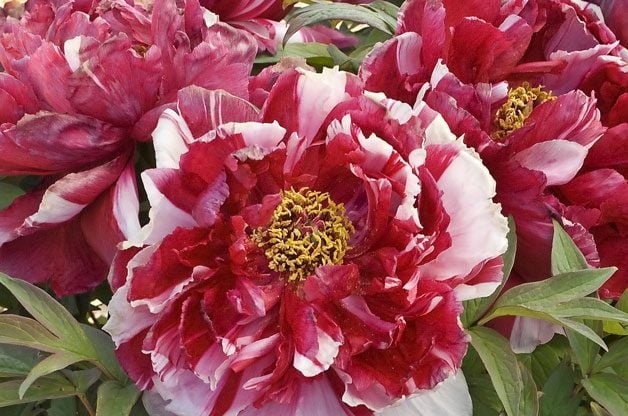
Paeonia, Zones 3 to 8
Add three seasons of charm with this old-fashioned favorite. Known for their large and often-fragrant flowers, the foliage also provides interest for multiple seasons. Watch as the leaves emerge with a reddish tint in spring, turn deep green for summer and finish off the season with purplish red shade in fall. Select varieties with stiff stems that do not need staking, like buckeye belle.
Why we love it: It’s a long-lived, low-maintenance perennial for sunny borders.
Plant peonies in your flower garden this fall.
Caradonna Salvia
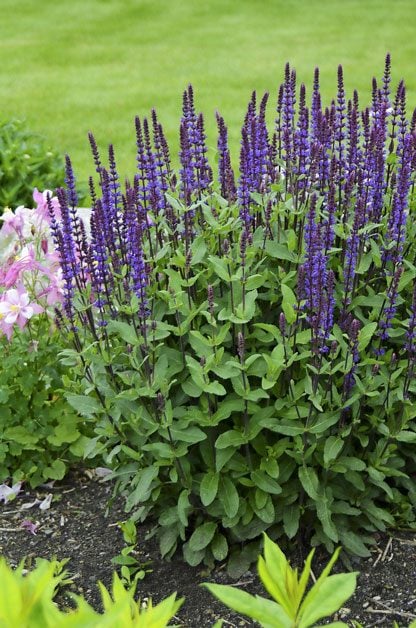
Salvia nemorosa ‘Caradonna,’Zones 3 to 9
The fragrant green foliage is topped with spikes of indigo flowers on purple-black stems in early summer. Deadhead faded flowers for additional bloom throughout the summer. Though it prefers full sun and moist, well-drained soil, it will tolerate drought, heat and humidity.
Why we love it: These edging plants bring hummingbirds and butterflies out to the border where we can get a closer look.
Check out 18 fabulous foliage plants for garden pizzazz.
Willow Amsonia
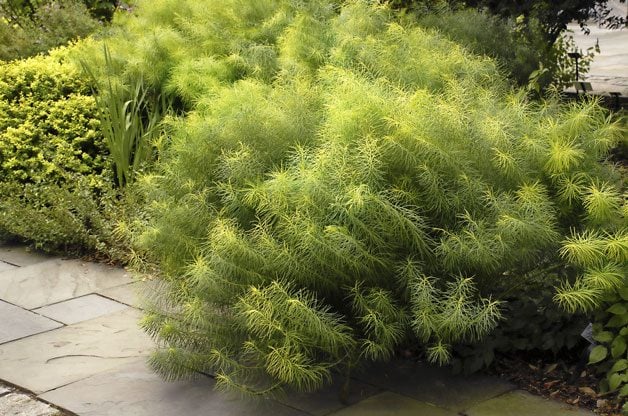
Amsonia Hubrichtii, Zones 4 to 9
Light blue, star-shaped flowers top the fine foliage of this spring blooming native, and the leaves seem to glow when they turn yellow-gold in the fall. You’ll have the best results growing this 3-foot tall plant in full sun. Avoid shade and over fertilizing because it can lead to floppy growth.
Why we love it: It’s drought-tolerant once established, and the deer tend to let it be.
Check out the top 10 easy-to-grow native plants.
Garden Phlox
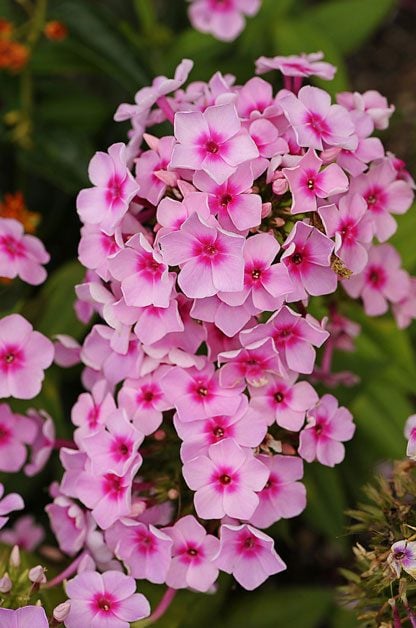
Phlox paniculata, Zones 4 to 8
Great for the middle or back of the border, garden phlox adds color to summer and fall garden borders. The white, pink, red, blue or purple flowers are often fragrant. Select powdery mildew-resistant varieties, and grow in full sun to light shade and moist, well-drained soil.
Why we love it: You’ll enjoy garden phlox in so many ways—including in the garden or as a cut flower. Plus, all the butterflies and hummingbirds it brings to your garden.
Switchgrass
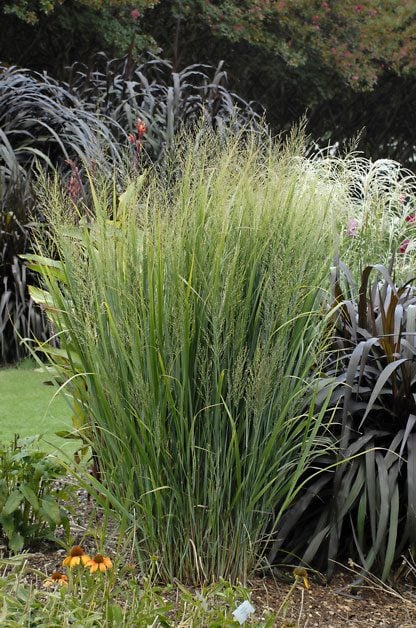
Panicum virgatum, Zones 3 to 9
In late summer the delicate light pink flowers hover above the fine foliage of this tall North American native grass. The yellow fall color and persistent seed heads extend your enjoyment into fall and winter. Select a clump-forming cultivar like Heavy Metal, Northwind or Shenandoah, which are more suitable for the garden.
Why we love it: You’ll enjoy the butterflies that visit the flowers and finches that feed on the seeds.
Snowbank False Aster
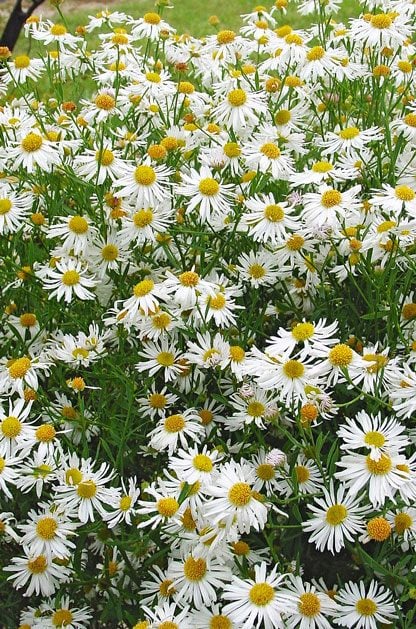
Boltonia asteroides ‘Snowbank’, Zones 4 to 8
The large size and fine texture of this plant make it a nice addition to the middle or back of the border. The small, white daisy-type flowers appear late summer through fall. Grow in full sun and well-drained soil for best results and to avoid the need for staking.
Why we love it: The flowers look like a cloud has descended onto your garden. The white blossoms brighten the night and fall garden.
Check out late summer and fall flowers that attract hummingbirds.
Dark Towers Beardtongue
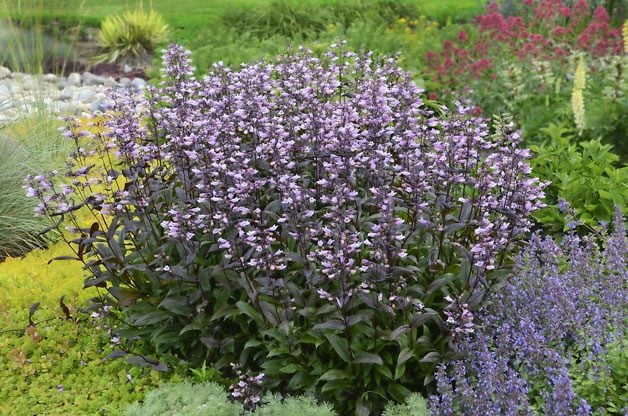
Penstemon ‘Dark Towers,’ Zones 3 to 9
Edging plants aren’t just for the front of the garden. This tall, summer-blooming border perennial will add color and vertical interest to the middle or back of the border. Bi-colored bell-shape blooms top the colorful foliage, which hummingbirds will love. Heat, humidity and drought tolerance makes this a good choice for sunny borders.
Why we love it: The reddish-purple foliage color persists throughout the season.
Check out the top 10 backyard vines with fall flair.
Zagreb Coreopsis

Coreopsis verticillata ‘Zagreb,’ Zones 3 to 9
Brighten the border with a long-blooming coreopsis. The ferny foliage creates a nice backdrop for small daisy-shaped flowers. This short coreopsis makes a great stand-alone edge plant, or tuck it along the front of other border plants for added color. Regular division will keep this perennial blooming with minimal deadheading.
Why We Love It: Not all edging plants give such reliable color. Yet, these flowers will enliven spaces from early summer all the way through fall.
We found 16 long-blooming flowers for attracting butterflies and hummingbirds.
Hardy Hibiscus
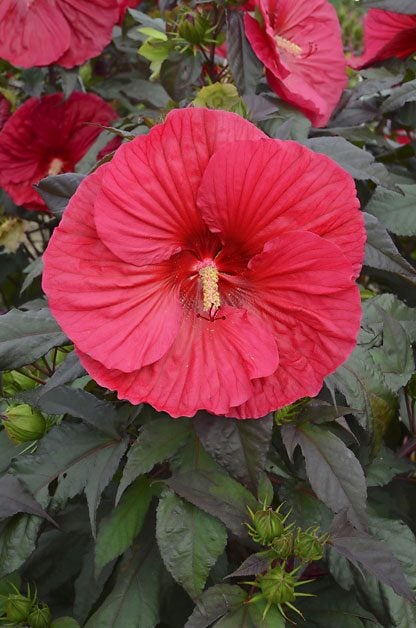
Hibiscus moscheutos, Zones 4 to 9
The 6- to 12-inch flowers of this back-of-the-border plant will wow you from summer through fall. Grow in full sun to partial shade with moist soil. It is one of the last perennials to emerge in spring. This means you’ll want to mark its location with a stake or spring flowering bulbs, so you don’t accidentally damage it during spring cleanup.
Why we love it: These edging plants are tall and make a statement, yet they seldom need staking.
Create a year-round garden with plants for all seasons.
Blazing Star
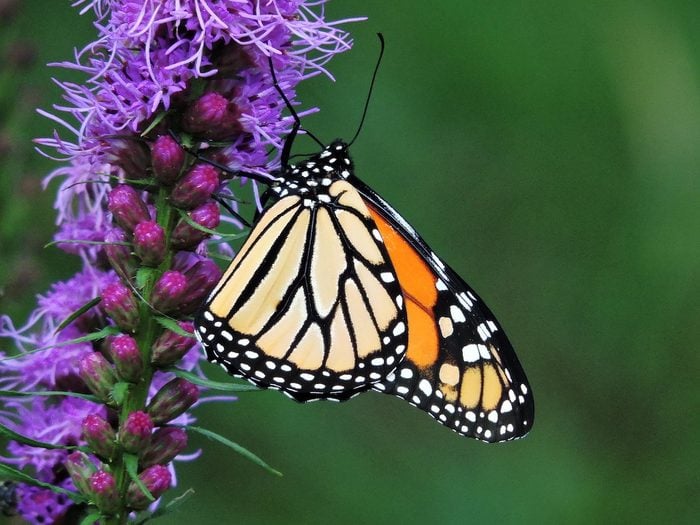
Liatris spicata, Zones 3 to 8
The purple or white spikes of blossoms add vertical interest to the flower garden and cut flower bouquets. Native to moist meadows and marshes, this native perennial prefers full sun and moist, well-drained soil, and it grows up to 4 feet. Select the variety Kobold, if you want more compact edging plants.
Why we love it: The seed heads provide winter interest and food for the birds.
How do you define cute? If you think about it, it’s rather subjective. What one person thinks is cute, another might not find attractive at all. So “cute,” in and of itself, is tricky, but now add the complication of trying to define cute birds. You’re sure to have all sorts of opinions! Now, we wouldn’t dream of identifying the cute birds in America all on our own. So we put together an online poll and asked you, the readers, to vote. While beauty and charm is in the eye of the beholder, these chipper, pint-size fliers will surely bring a smile to your face.
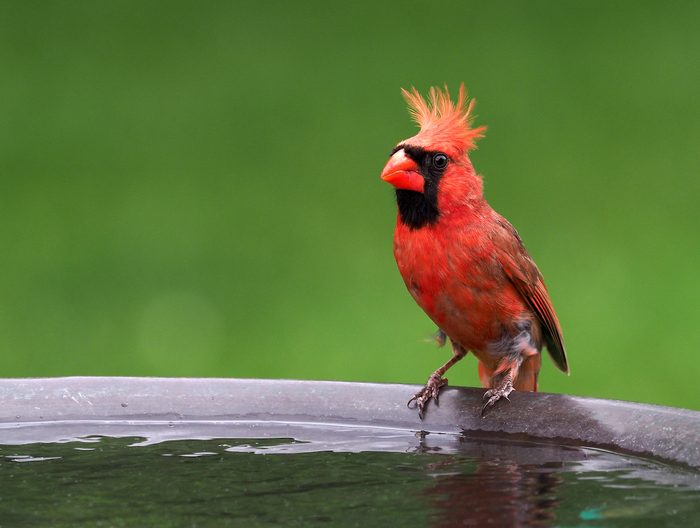
1: Northern Cardinal
While male northern cardinals are stunningly bright and showy, females are no slouches in the cuteness category either. They have subtle hints of blush that appear as if whimsically painted on. Cardinals prefer platform feeders for foraging on black oil sunflower and safflower feasts. If you don’t have space for an additional feeder, add a tray to the bottom of your tube feeder to give cardinals a place to perch and eat.

2: American Goldfinch
Goldfinches glow like beams of sunshine in summer and ebb to rich olive green in winter. These widespread cuties are recognized as the state bird of Iowa, New Jersey and Washington. While they eat a variety of seeds, a tube or sock feeder full of thistle is a magnet for finches. The fine seeds dry out if kept in storage for too long, so consider buying smaller bags rather than stocking up.
Backyard Tip: Use an upside-down thistle feeder to keep goldfinches around but bully birds away!

3. Ruby-Crowned Kinglet
Like feathered pingpong balls with toothpick legs, ruby-crowned kinglets bounce and flit about, flicking their wings in near constant motion. Kinglets are most visible in winter along the coasts and throughout the southern states, but migrants show up anywhere. Despite their bug-filled diet, they occasionally nibble on suet cakes. Bold white eye-rings give these little nuggets personality. Red crown feathers are usually tucked away among the gray plumage. Check out the top 9 most beautiful birds in America.

4: Indigo Bunting
The color of the male indigo bunting has to be one of the most vibrant, gorgeous blues found in nature. It’s almost iridescent, like a peacock. Females are a dull brown, but you can still identify them by their thicker grosbeak bill. These birds are migrants and are common throughout the East in late spring and summer. If you want to attract them to your yard, try mealworms or a thistle feeder. Indigo buntings also love white millet seed.

5: Rufous Hummingbird
We couldn’t put every hummingbird on the nomination list for cute birds, because we were afraid they would dominate. After all, nearly everyone can agree that a 3- to 4-inch hummingbird is cute! The rufous came in at a solid fifth on our list. It’s found mostly in the West, though some rufous hummingbirds are gaining a reputation for wintering in the lower Southeast. The male has a stunning gorget and beautiful cinnamon coloring across his back. Offer sugar water for all hummingbirds. Discover jaw-dropping facts about hummingbirds.

6. Dark-Eyed Junco
Called snowbirds across much of the continent, flocks of dark-eyed juncos are harbingers of winter and holiday cheer. For many years, separate types of juncos were classified as unique species, but now scientists identify them all as dark-eyed juncos. Most of them have delightful pink bills, and their white outer tail feathers flash as they fly by. These members of the sparrow family use brush piles for cover and feed on birdseed scattered directly on the ground.
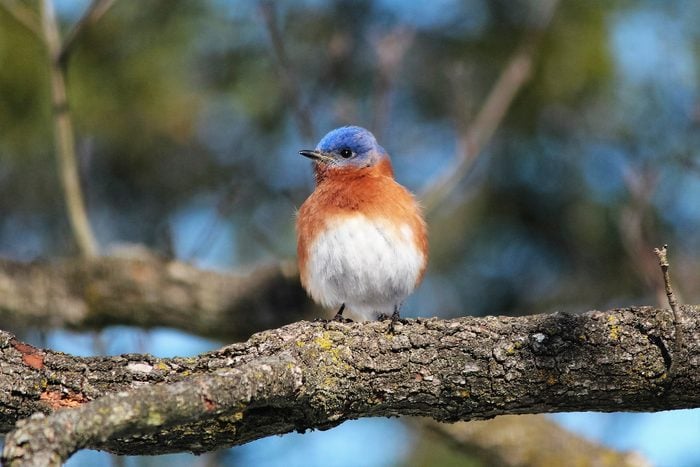
7. Eastern Bluebird
Along with their western counterparts, eastern bluebirds are beautifully patterned with rusty maroons that contrast against brilliant blues. Bluebirds perch conspicuously in open areas. To attract them, set out nesting boxes. You may even see some fledglings, come summer! If you are lucky enough to have bluebirds in your neighborhood but not your yard, they might take mealworms from a feeder. Native landscapes with fruiting trees also attract bluebirds to backyards.

8. Northern Saw-Whet Owl
Despite being named after the sound of sharpening blades on whetstones, the tiny northern saw-whet owl’s charming toot, toot, toot calls are hardly menacing. The pint-size owls stand just about 8 inches tall, with oversized, endearing eyes. The alarm notes of songbirds may draw your attention to a roosting saw-whet owl in a dense conifer stand. You might also see the elusive birds at a banding program as researchers continue to learn more about their distribution, mostly in the forests of northern and western North America.

9. Yellow Warbler
Listen for the cheerful sweet, sweet, sweet tweets of yellow warblers in brushy habitats. You might see a lemon-hued male sporting orange streaks on his chest, or a soft yellow female. Warblers feed mostly on insects, so they generally aren’t attracted to feeders. Instead, entice these cute birds to your garden by adding a water feature like a bird bath or, even better, a natural looking pond with flowing water.

10. Downy Woodpecker
The daintiest of the woodpeckers, downies are familiar friends in backyards from coast to coast. They seem delicate even as they chisel out cavities in tree trunks, one chunk at a time. Downy woodpeckers eat a variety of foods including seeds, fruits and insects, and they visit suet feeders throughout the year. No-melt suet is available for warmer months. But definitely serve high-fat treats during the winter when downies need the extra nutrients.

11. Black-Capped Chickadee
Don’t be mad, but we left these cute birds off our list the first time. We heard about it, too! Several people wrote in, asking us how we could forget the black-capped chickadee. We publicly apologize to those who were shocked by our omission. Who doesn’t love this little black-and-white flier, found throughout much of the U.S.? You can easily attract chickadees with black-oil sunflower seed. Check out 20 incredibly cute chickadee pictures.
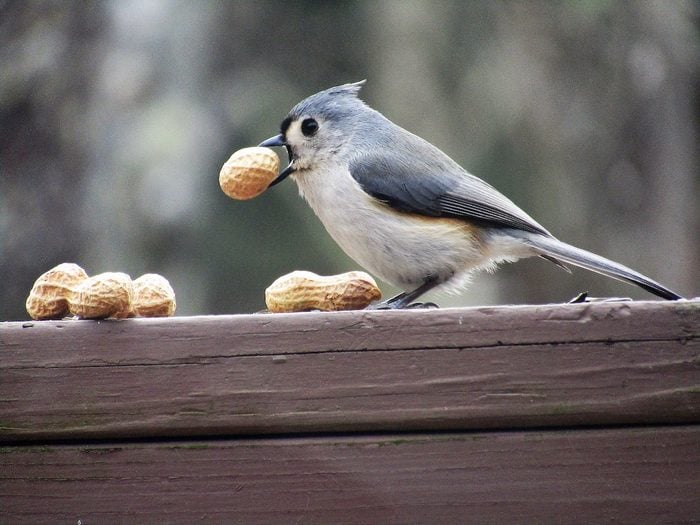
12. Tufted Titmouse
It isn’t the only crested bird around, but a tufted titmouse’s peak certainly has the most flair. Both sexes always look styled and perfectly moussed, with vibrant black eyes to offset their pale expressive faces. With a range that’s expanding northward, these cute birds are common feeder visitors in the East. They readily eat sunflower seeds, but it is especially amusing to watch them tackle whole peanuts in the shell. Learn how to attract titmice to visit your backyard.

Japanese Beetle Control
“How do I control Japanese beetles and stop them from eating my hibiscus plants?” asks Mary Brigham of Spring Arbor, Michigan.
Japanese beetles feed on hibiscus and many other plants, causing this type of leaf damage (above). Healthy plants will survive the beetles’ nibbling, but look unsightly. Watch your garden closely for these coppery green beetles that eat and mate throughout the day. When you see them, remove them.
Psst‚ here’s how to get rid of the worst garden insects—and how to keep squash bugs out of your garden.

To control a Japanese beetle infestation, try knocking them into a can of soapy water or use a small hand-held vacuum to remove and eliminate them. You can also shield your garden beds with floating row covers to keep Japanese beetles from dining on susceptible plants. An organic insecticide containing the bacteria Bacillus thuringiensis galleriae is now also available to control these garden pests. This strain of bacteria is effective against Japanese beetles and some other types of beetles but not harmful to other wildlife, beneficial bugs, people or pets.
Learn how to get rid of slugs and snails in the garden. Plus, if you see spotted lanternflies in your yard, here’s what you should do.
As always, read and follow label instructions for any organic, natural or synthetic products you apply to the garden.
Next, try these natural ways to eliminate garden insect pests.

Northern Cardinal is a Popular Pick
The northern cardinal gets top honors among state birds, representing seven states total: Illinois, Indiana, Kentucky, North Carolina, Ohio, Virginia and West Virginia. The Western meadowlark and mockingbird are also popular choices.
Take our state birds quiz to see how many you can name.
Hungry Gulls to the Rescue in Utah
Utah selected the California gull as its state bird after its heroic eating efforts in 1848, which saved many Mormon settlers from losing their crops to an insect plague.
Do you know the national flower, bird and tree of the United States?
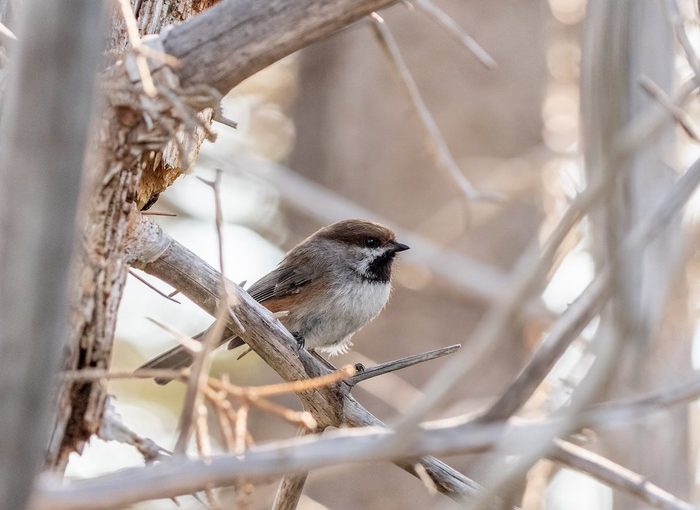
Maine’s Chickadee Confusion
Though Maine is home to two species of chickadee (the common black-capped and the elusive boreal), the state’s bird choice is officially listed as simply “the chickadee.” So Maine bird lovers can take their pick of these small songbirds.
You have to see these 20 incredibly cute chickadee photos!

Hawaii’s Bird Gets a Boost
Good news! One state bird was able to move off the endangered species list. Hawaii’s nene population is recovering thanks to conservation efforts.
Discover 20 types of ducks to look for in across America.
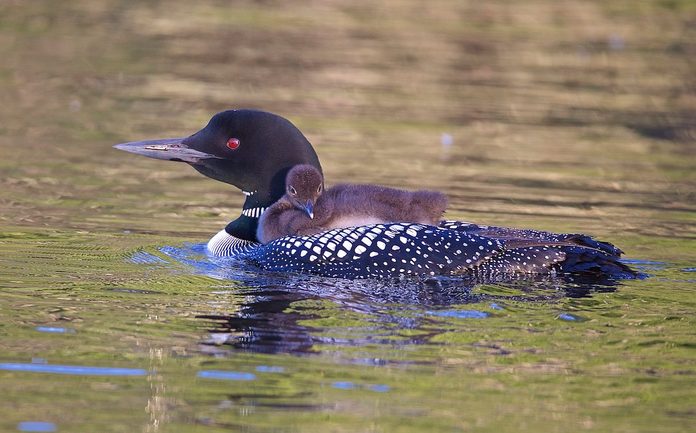
Standalone State Birds
Nineteen bird species represent only one state each, including the greater roadrunner (New Mexico), common loon (Minnesota) and brown pelican (Louisiana).
Find out which species is the most commonly seen bird in every state.
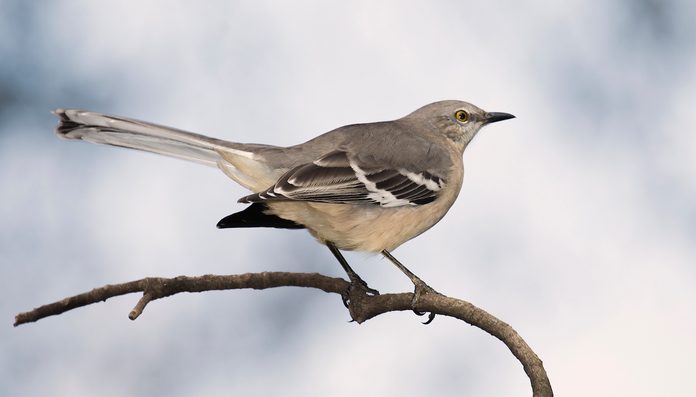
The History of State Birds
The General Federation of Women’s Clubs gets credit for first launching the idea of adopting state birds during the 1920s.
Next, learn which brainy birds are America’s smartest bird species.
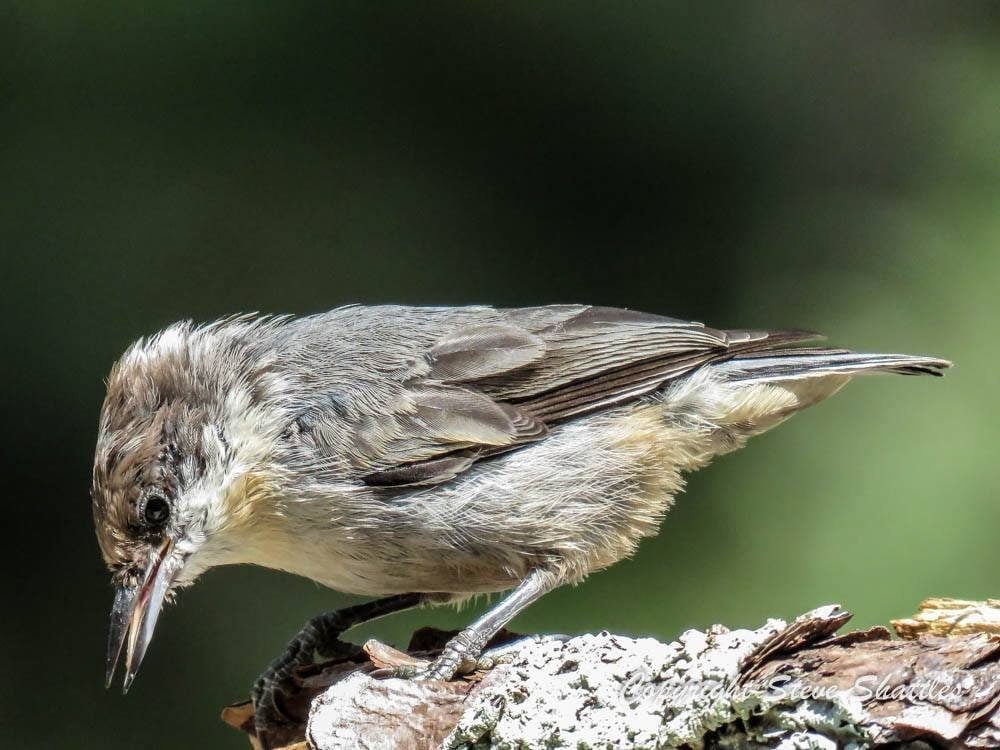
What Do Nuthatches Eat?
The most common backyard nuthatches are white-breasted nuthatches and red-breasted nuthatches. Other North American nuthatches can be found in specialized habitats—brown-headed nuthatches live in the Deep South and pygmy nuthatches in western forests. If you want to attract nuthatches, you have probably asked what do nuthatches eat?
Insects are the main food source for nuthatches. The birds search bark and crevices for hidden treats like beetles, spiders, ants and caterpillars as they dance around tree trunks. Nuthatches will also visit backyard feeders, especially if you have a yard full of trees they can use for foraging and shelter. Stock your feeders with their favorite foods, and you’ll be on your way to attracting nuthatches.
Fascinating fact: Not only do nuthatches search crevices for food, they also hide food in them. They will stuff seeds or insects in holes in trees and cleverly cover their hiding spots with lichens, moss or pieces of bark. The nuthatches will return to this hidden food and use it as nourishment to get through winter.
Suet
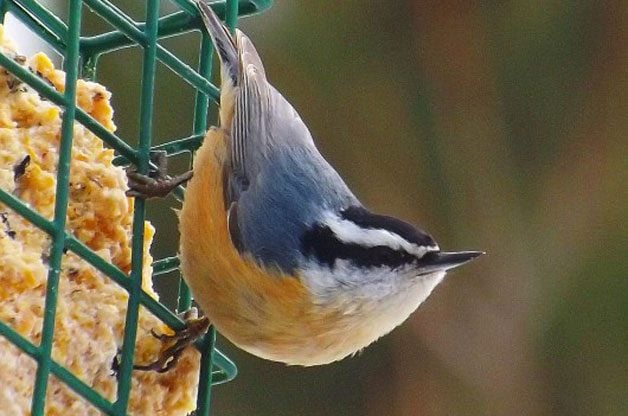
Whether you make your own suet or buy it, a suet block in a cage-like feeder is sure to attract nuthatches. In the winter months, when conifer seeds are sometimes scarce, red-breasted nuthatches will travel in search of food and will likely stop at feeders for a suet snack. Add peanut butter to your DIY suet mixture and white-breasted nuthatches will love it even more!
Check out the best suet feeders for winter birds.
Sunflower Seeds
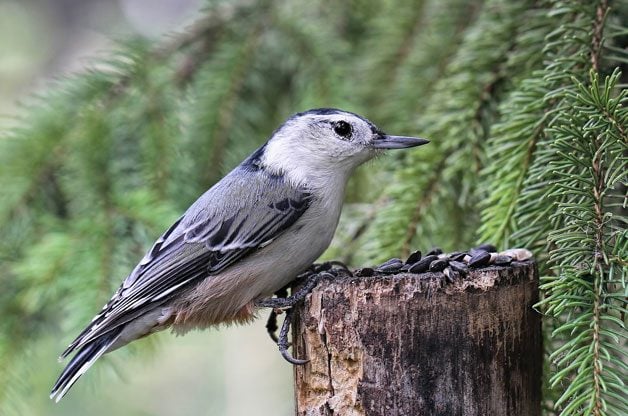
Any form of sunflower seed will attract desirable birds, but when it comes to feeding nuthatches, serving up black oil sunflower seeds is a slam dunk. Because bully birds also seek out black oil sunflower seeds, a tube feeder with small perches is best.
Check out the 10 types of bird feeders you need in your backyard.
Peanuts
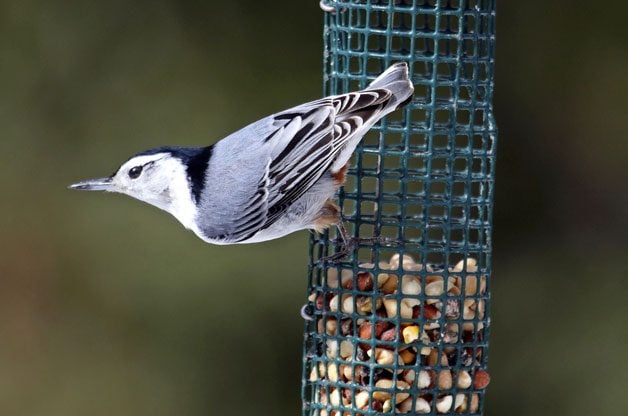
If you don’t have a peanut feeder yet, get your hands on one for this upcoming cold season. Here’s how to make a DIY bird feeder for peanuts. Red and white-breasted nuthatches will entertain you for hours scurrying up, down and around a peanut feeder. Their favorite food to eat? Out of the shell, unsalted peanuts.
Here’s how to attract more birds by feeding peanuts.
Live Mealworms
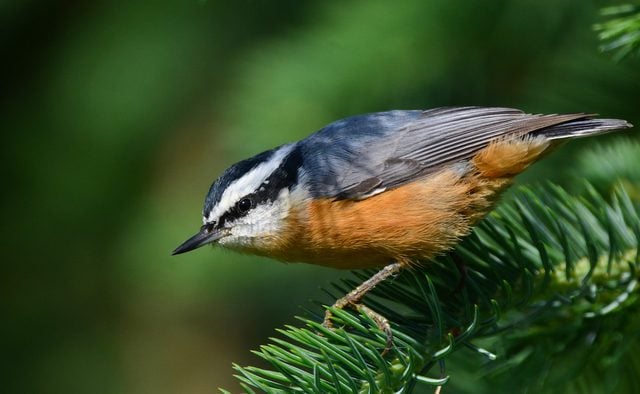
More species than just bluebirds enjoy a mealworm snack. A large portion of the nuthatch diet is insects, so putting out mealworms for them is definitely worth a shot. They don’t require anything fancy; just toss some mealworms in a shallow tray or platform feeder and cross your fingers. Check out our guide to feeding mealworms to birds.
Next, check out the 4 best foods for attracting woodpeckers.
